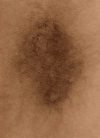Combined Laser Therapy for Post-sclerotherapy Hyperpigmentation Following Nicolau Syndrome: A Case Report
- PMID: 40385807
- PMCID: PMC12083511
- DOI: 10.7759/cureus.82375
Combined Laser Therapy for Post-sclerotherapy Hyperpigmentation Following Nicolau Syndrome: A Case Report
Abstract
Post-sclerotherapy hyperpigmentation is a common adverse effect, particularly when complicated by Nicolau syndrome, a rare injection-related event that can lead to tissue necrosis and persistent pigmentary changes. We report a case of a 40-year-old woman with Fitzpatrick skin type II, who developed longstanding hyperpigmentation in the right popliteal area following polidocanol sclerotherapy. Clinical and dermoscopic examination revealed mixed melanin and hemosiderin deposition. The patient was successfully treated using a quadrant-specific multimodal laser approach combining intense pulsed light (IPL), Q-switched neodymium-doped yttrium aluminum garnet (Nd:YAG), and erbium-doped yttrium aluminum garnet (Er:YAG) lasers over two sessions. Notable pigment clearance, full crust exfoliation, and restoration of normal skin tone were achieved without adverse effects. Independent expert evaluation and patient-reported outcomes confirmed the treatment's efficacy and high tolerability.
Keywords: er:yag; ipl; laser therapy; nicolau syndrome; post-sclerotherapy hyperpigmentation; q-switched nd:yag.
Copyright © 2025, Alekseev et al.
Conflict of interest statement
Human subjects: Consent for treatment and open access publication was obtained or waived by all participants in this study. Conflicts of interest: In compliance with the ICMJE uniform disclosure form, all authors declare the following: Payment/services info: All authors have declared that no financial support was received from any organization for the submitted work. Financial relationships: All authors have declared that they have no financial relationships at present or within the previous three years with any organizations that might have an interest in the submitted work. Other relationships: All authors have declared that there are no other relationships or activities that could appear to have influenced the submitted work.
Figures






Similar articles
-
Comparison between the use of intense pulsed light and Q-switched neodymium-doped yttrium aluminum garnet laser for the treatment of axillary hyperpigmentation.J Cosmet Dermatol. 2021 Sep;20(9):2785-2793. doi: 10.1111/jocd.13981. Epub 2021 Feb 15. J Cosmet Dermatol. 2021. PMID: 33550634
-
Comparison among Intense Pulsed Light, Alexandrite, and Long-Pulsed Neodymium-Doped Yttrium Aluminum Garnet 1064 Nm Lasers for Lower Leg Hair Removal: Case Series.Int J Trichology. 2023 Sep-Oct;15(5):197-203. doi: 10.4103/ijt.ijt_110_21. Epub 2024 Jul 11. Int J Trichology. 2023. PMID: 39170086 Free PMC article.
-
Short-term results of the combined application of neodymium-doped yttrium aluminum garnet (Nd:YAG) laser and erbium-doped yttrium aluminum garnet (Er:YAG) laser in the treatment of periodontal disease: a randomized controlled trial.Clin Oral Investig. 2021 Nov;25(11):6119-6126. doi: 10.1007/s00784-021-03911-x. Epub 2021 Apr 4. Clin Oral Investig. 2021. PMID: 33813638 Free PMC article. Clinical Trial.
-
The efficacy of high-intensity laser therapy in wound healing: a narrative review.Lasers Med Sci. 2024 Aug 3;39(1):208. doi: 10.1007/s10103-024-04146-4. Lasers Med Sci. 2024. PMID: 39096352 Review.
-
The Asian dermatologic patient: review of common pigmentary disorders and cutaneous diseases.Am J Clin Dermatol. 2009;10(3):153-68. doi: 10.2165/00128071-200910030-00002. Am J Clin Dermatol. 2009. PMID: 19354330 Review.
References
-
- Skin hyperpigmentation after sclerotherapy with polidocanol: a systematic review. Bossart S, Daneluzzi C, Cazzaniga S, et al. J Eur Acad Dermatol Venereol. 2023;37:274–283. - PubMed
-
- Nicolau syndrome: a report of 2 cases. Mutalik S, Belgaumkar V. https://pubmed.ncbi.nlm.nih.gov/16673810/ J Drugs Dermatol. 2006;5:377–378. - PubMed
-
- Localized retiform purpura after accidental intra-arterial injection of polidocanol. Yébenes M, Gilaberte M, Toll A, Barranco C, Pujol RM. Acta Derm Venereol. 2005;85:372–373. - PubMed
-
- Nicolau syndrome following intramuscular benzathine penicillin. De Sousa R, Dang A, Rataboli PV. J Postgrad Med. 2008;54:332–334. - PubMed
Publication types
LinkOut - more resources
Full Text Sources
